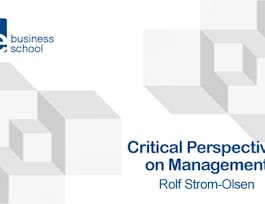Strategic Organization Design will introduce new topics and modules with even more real world examples and opportunities for student interaction than its predecessors Competitive Strategy (https://www.coursera.org/learn/competitive-strategy) and Advanced Competitive Strategy (https://www.coursera.org/learn/advanced-competitive-strategy).



Strategic Organization Design
This course is part of Competitive Strategy and Organization Design Specialization

Instructor: Tobias Kretschmer
Sponsored by BrightStar Care
13,735 already enrolled
(293 reviews)
Skills you'll gain
Details to know

Add to your LinkedIn profile
16 assignments
See how employees at top companies are mastering in-demand skills

Build your subject-matter expertise
- Learn new concepts from industry experts
- Gain a foundational understanding of a subject or tool
- Develop job-relevant skills with hands-on projects
- Earn a shareable career certificate


Earn a career certificate
Add this credential to your LinkedIn profile, resume, or CV
Share it on social media and in your performance review

There are 6 modules in this course
This module will introduce the fundamental dimensions of organization design. We will take a designer’s point of view and first introduce the “objective” elements of organization design, the organizational structure. This is reflected in the organization chart, the size and importance of the functional units, the organization by product lines, functions or geographical units. The second part of the module will cover other elements that govern the interaction between units and individuals, such as the degree of formalization and centralization, the reward system and the degree of task division.
What's included
9 videos2 readings3 assignments1 discussion prompt
This module will integrate the elements laid out in the previous one. For an organization designer, it is crucial to realize that each of the elements will interact with others. For example, screening employees for their intrinsic motivation and subsequently leaving them little autonomy would lead to decreased performance. After laying out the general patterns of complementarity and substitutability, the module will proceed to outline the consequences for changing an organization’s design. Changes of a single design element will likely trigger further changes in other, related elements, and some organizational aspects like corporate culture or existing human capital may not be easy to change, if at all.
What's included
7 videos1 reading3 assignments1 discussion prompt
The design of an organization is also affected by the firm’s environment. Firms finding themselves in a competitive environment may have to compete for key resources, including employees, with other firms, which may affect the way they recruit, but it may also have repercussions for the type of employees, or other resources, the firm can acquire. Similarly, if firms strive to continuously innovate and seek out new market opportunities, they have to be designed in a way to support this goal. Thus, a firm’s strategy, its competitive environment and its organization design have to be aligned to help a firm achieve its objective.
What's included
7 videos1 reading3 assignments1 discussion prompt
This module will highlight the role of the corporate office in a number of ways. First, its importance in corporate decision-making is analyzed: On the one hand, the corporate office is best placed to take the firm’s overall objectives into account, so corporate choices may be more efficient if taken by the corporate office. On the other hand, lower ranks in the hierarchy often carry more detailed information about the immediate challenges and changes in the different activities of the firm. Second, this module looks at the scope of decisions the corporate office takes. While some corporate offices restrict themselves to providing an internal financial market, others will heavily control the specific actions of the lower-ranked units.
What's included
7 videos1 reading2 assignments1 discussion prompt
This final module of the course will combine many of the aspects learned in the earlier modules. Imagine you are an entrepreneur with a strategic vision to enter a market with specific competitive conditions and a plan for growth. How will you set up an organization that is both effective in the environment it is currently facing so that it is successful in the short term, but also effective in managing and facilitating the growth needed to survive in the long term. The tension between efficiency (in the short run) and flexibility (in the long run) is crucial and this module will discuss options of how to manage it and what role an organization designer can play in this. The final module will therefore serve as a summary of the course content, but also as a practical guide to combine all the aspects above in the actual planning process from foundation to maturity of a firm.
What's included
9 videos1 reading4 assignments1 discussion prompt
What's included
1 assignment
Instructor

Why people choose Coursera for their career




Learner reviews
293 reviews
- 5 stars
72.54%
- 4 stars
18.98%
- 3 stars
6.10%
- 2 stars
1.35%
- 1 star
1.01%
Showing 3 of 293
Reviewed on May 14, 2020
i have learned a lot from this course this has the very impact on the the employees whose working in the organisation
Reviewed on May 22, 2020
One of the best courses I have ever watched if not the best; the presenter was engaging and easy in his approach.
Reviewed on Jan 11, 2018
Excellent course that is fully applicable in real world. The theory explained is demonstrable in real life companies.
Recommended if you're interested in Business

IE Business School

West Virginia University

Copenhagen Business School

Fundação Instituto de Administração

Open new doors with Coursera Plus
Unlimited access to 10,000+ world-class courses, hands-on projects, and job-ready certificate programs - all included in your subscription
Advance your career with an online degree
Earn a degree from world-class universities - 100% online
Join over 3,400 global companies that choose Coursera for Business
Upskill your employees to excel in the digital economy


